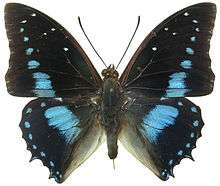Charaxes imperialis
Charaxes imperialis, the imperial blue charaxes, is a butterfly in the family Nymphalidae. It is found in Guinea-Bissau, Guinea, Sierra Leone, Liberia, Ivory Coast, Ghana, Benin, Nigeria, Cameroon, Equatorial Guinea, the Republic of the Congo, the Central African Republic, the Democratic Republic of the Congo, Rwanda, Uganda, Tanzania and Zambia.[2] The habitat consists of lowland to sub-montane forests.
| Charaxes imperialis | |
|---|---|
 | |
| From the CAR | |
| Scientific classification | |
| Kingdom: | Animalia |
| Phylum: | Arthropoda |
| Class: | Insecta |
| Order: | Lepidoptera |
| Family: | Nymphalidae |
| Genus: | Charaxes |
| Species: | C. imperialis |
| Binomial name | |
| Charaxes imperialis | |
| Synonyms | |
| |
The larvae probably feed on Sapindaceae species.
Taxonomy
Charaxes tiridates group.
The supposed clade members are:
- Charaxes tiridates
- Charaxes numenes similar to next
- Charaxes bipunctatus similar to last
- Charaxes violetta
- Charaxes fuscus
- Charaxes mixtus
- Charaxes bubastis
- Charaxes albimaculatus
- Charaxes barnsi
- Charaxes bohemani
- Charaxes schoutedeni
- Charaxes monteiri
- Charaxes smaragdalis
- Charaxes xiphares
- Charaxes cithaeron
- Charaxes nandina
- Charaxes imperialis
- Charaxes ameliae
- Charaxes pythodoris
- ? Charaxes overlaeti
For a full list see Eric Vingerhoedt, 2013.[3]
Subspecies
- C. i. imperialis (Guinea-Bissau, Guinea, Sierra Leone, Liberia, Ivory Coast, Ghana, Benin)
- C. i. albipuncta Joicey & Talbot, 1920 (Nigeria, Cameroon, Central African Republic, northern Democratic Republic of the Congo)
- C. i. dargei Collins, 1989 (southern Congo)
- C. i. graziellae Turlin, 1989 (Tanzania: north-west to the Mumwendo Forest)
- C. i. lisomboensis van Someren, 1975 (north-eastern Zambia, Tanzania: Kigoma)
- C. i. nathaliae Canu, 1989 (Bioko)
- C. i. pauliani Rousseau-Decelle, 1933 (Democratic Republic of the Congo: south to Lualaba)
- C. i. ugandicus van Someren, 1972 (Uganda, Democratic Republic of the Congo: north Kivu)
- C. i. werneri Turlin, 1989 (Rwanda: Nyungwe Forest)
gollark: Even if they're fine themselves.
gollark: They will, again, quite possibly infect people.
gollark: Not really, reinfection seems to have been veeeery rare.
gollark: Except they are transmitting it while they, well, have it, so no.
gollark: ???
References
| Wikimedia Commons has media related to Charaxes imperialis. |
| Wikispecies has information related to Charaxes imperialis |
- "Charaxes Ochsenheimer, 1816" at Markku Savela's Lepidoptera and Some Other Life Forms
- Afrotropical Butterflies: File H - Charaxinae - Tribe Charaxini
- "African Charaxes/Charaxes Africains Eric Vingerhoedt, 2013". Archived from the original on 2013-06-27.
External links
- Charaxes imperialis images at Consortium for the Barcode of Life
- 99688 C. i. imperialis images at BOLD
- C. i. albipunctatus images at BOLD
- C. i. dargei images at BOLD
- C. i. paulinus images at BOLD
- C. i. werneri images at BOLD
- Images of C. i. albipuncta Royal Museum for Central Africa (Albertine Rift Project)
- Images of C. i. imperialis (Albertine Rift Project)
- Images of C. i. pauliani (Albertine Rift Project)
This article is issued from Wikipedia. The text is licensed under Creative Commons - Attribution - Sharealike. Additional terms may apply for the media files.